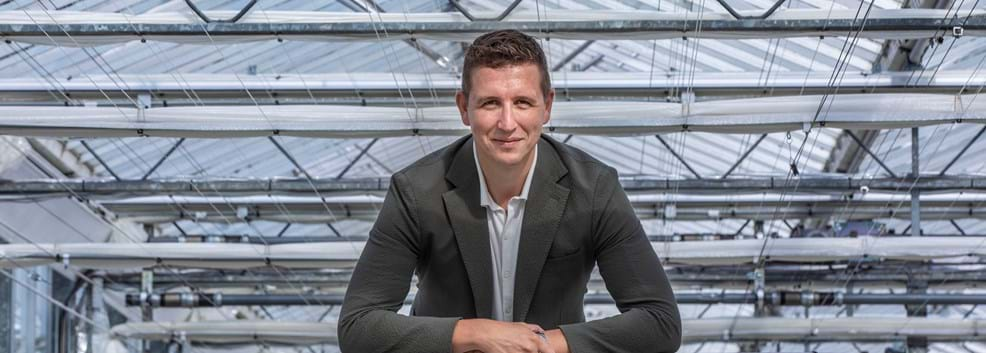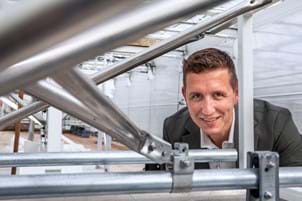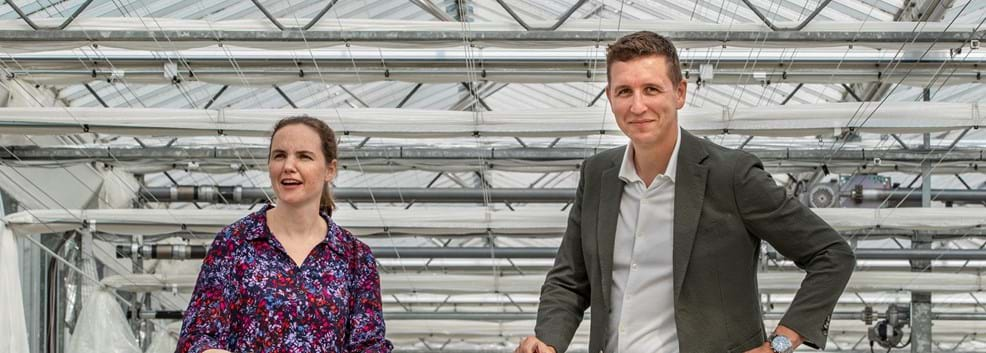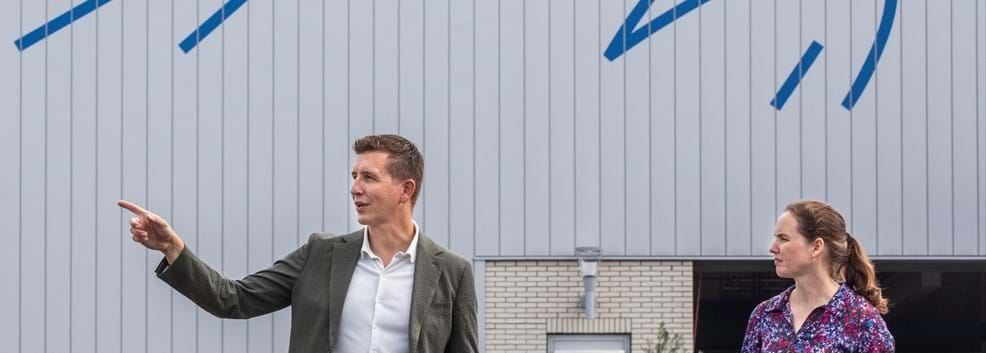A relentless drive to innovate and improve is what made Van der Valk Systemen market leader in screen systems and ventilation mechanisms in greenhouses. This drive originated with founder Hans van der Valk, and continues with Vincent Prins, the current R&D manager. The innovative spirit that made the family business successful in greenhouses proved to be a recipe for success in solar systems too. "It's in our blood that we want to improve everything."
A couple of times during the interview in the meeting room at Van der Valk Systemen - Monster, The Netherlands - Vincent Prins gets up to retrieve something to illustrate his story. Like the two metal rods which are now on the table: one looks almost brand new, the other rusty and cracked. These are push rods which are used to open and close greenhouse windows. One of the differences between the two rods: an innovative hole measuring a couple of millimetres on the underside. This smart condensation hole prevents moisture accumulation and frost damage. The rod with the hole is a Van der Valk invention, the ValkPushRod, the other comes from a competitor.
Vincent Prins is using the rods to demonstrate the importance of details for the quality of the Van der Valk systems. Liselot Arkesteijn, NLO’s patent attorney who has been managing the company’s patent applications, confirmed this too: "Every corner, every connector, every edge of their products is considered. Every detail has a function." The seed for this way of working was sown when Hans van der Valk, then aged exactly 15 years and 1 day, started work in his father’s greenhouse construction company in 1963. After a few years of doing construction work, it became clear where his real talents lay: in finding smart ways to make that heavy work lighter, faster and cheaper. "Hans is a real inventor," says Vincent Prins, "He immediately saw what could be done more efficiently and smarter."
One of the first things he introduced was a metal split pin with which the push rods were attached to the greenhouse windows. This ensured easier and faster installation and they cost a fraction of the nuts and bolts previously used. To ventilate the greenhouse, the windows used to be opened manually, one by one, with a stick, says Vincent Prins. "Now there are automatic systems allowing the ventilation of hectares of greenhouses to be regulated at the same time. Obviously, that sets extremely high standards with respect to the quality and lifespan of the components." One of those components is still the split pen where it all started for Van der Valk. At least, its latest version. Again, Vincent Prins presents several examples to demonstrate the development and improvement of the seemingly simple split pen, the ValkLockPin, over the past 50 years.
As an inventor, Vincent Prins has learned to think like Hans van der Valk. He has worked for the company for 17 years, during which time he has set up an entire R&D department. He knows every detail of the two thousand unique products supplied by the company - "apart from the nuts and bolts, everything is invented and developed here". He gives the impression that he could easily spend half an hour enthusiastically talking about each of these products, explaining why each one looks the way it does and not like something else. Many of his ideas take shape outside working hours, in the car or in the shower, in drawings on the condensation on the shower wall.
You are involved with nearly all the recent patents and applications of Van der Valk Systemen. What are you most proud of?
"That’s a difficult question. Inventions are like your children; they all emerge from ideas we once had. But if I had to name one, it would be one from my early days. I was asked whether I could design a better system for controlling screens in a greenhouse. Part of that system involved a drum from which a cable was wound on and off. The drum was awkward in the installation and very cumbersome to produce. Together with our customers, people in the factory and machine builders, I started working on a completely new design. Eventually, I created a new version which was a huge improvement in every respect. So, that’s one thing I’m very proud of. It has so much that is different from what competitors were doing, and that makes it so much fun to sell."
Do you ever not succeed in making something better?
"Oddly enough, no. It’s actually always possible. Because we just never stop. That’s what I like about the culture in this company. It’s in our blood that we want to improve everything. Inventing just never stops. And to stay at the top, we will need to continue innovating and improving."
That attitude is the basis for a new branch of the company. That step started with attempts to develop outside screens for greenhouses, involving a screen being placed on top of the greenhouse. To protect the folded screens from all kinds of weather, the original idea was to install solar panels on top of them.
Gradually, we realised that there was a much bigger opportunity here. Horticulture wants to become more sustainable, and Van der Valk can use their existing know-how and machines for the production of solar panel mounting systems. But above all, there is the conviction that so much can be done to improve these systems.
How do you explain that success in what is a new market for you where there was already a lot of competition?
"Again, by continuing to innovate and improve. Solar really started because we began to pioneer. When you believe that you have created something good, it is important to continue taking the next steps. Always wondering how we can make the work of installers as easy and efficient as possible. Firstly, you make a system just for flat roofs, then for sloping roofs, and because different roof constructions are used in neighbouring countries, an adapted system needs to be thought up for each country. We have now also developed software that enables customers to calculate how much ballast is required on their roof. We are therefore doing lots of wind tunnel tests to see how we can reduce that ballast so that systems can become lighter and thus more sustainable. As you can see, we’ve still got lots to do."
The interview takes place just before the weekend when the company will be celebrating its 60th anniversary, including the festive opening of three factory halls with 8,000 square metres of additional production area.
How can a production company be successful and continue to grow in the Netherlands without relocating activities to Asia, for example?
"There are several reasons. Firstly, our production process of smart innovations is all linked together. We are constantly thinking about the optimal design and how we can produce more efficiently, faster, and more reliably. A lot of the manual work is outsourced to social workplaces. As a result, we have very automated, high-tech equipment with lots of machines that have been specially developed for us. And that’s another reason: the partnership with our customers and suppliers, often local companies with whom we have been doing business for years. Growers here in the Westland are among the world’s best in terms of efficiency and quality. Our innovation is strongly driven by their wishes and requirements. If we can fulfil those needs, we will also continue to make progress.
The same applies to our suppliers.The machine that we use to make the split pens lock is the result of decades of developments jointly achieved with the machine builder. For us, there are great advantages to continue doing things close to home."
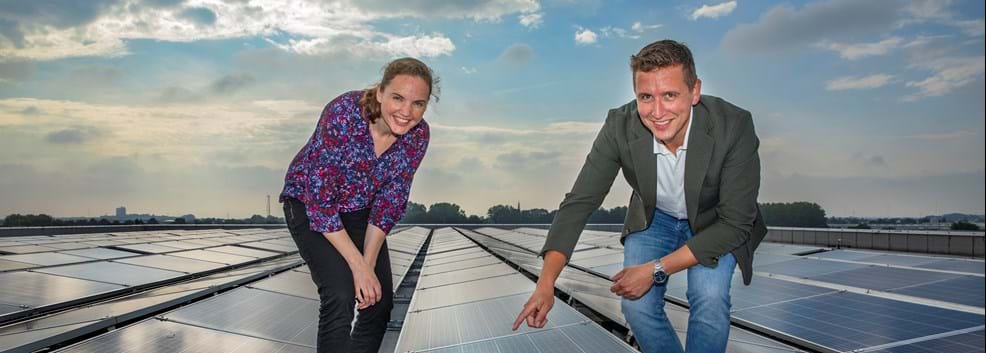
You not only make a lot of products, you also have lots of patents. What role do they play in your company?
"There are two sides to that. We devote a lot of time and money to developing our products, so we want them to be well protected too. And you are kept on your toes by studying what other people do. From that, you learn how the market is organised and the direction it’s going. We’ve known the horticultural industry inside and out for 60 years, but particularly in solar it’s important to be able to follow all the rapid developments."
Having a patent is one thing, preventing infringement is another. How do you prevent that in products that competitors can analyse in detail?
"The fact that our products are patented, and that we label them as such in some cases, acts as a kind of deterrent to serious competitors. They stay away from what we are doing and need to work around it. If any parties rashly copy our products, we will confront them. But an important aspect of our protection is that many of the things we do here are really unique. There are often so many smart innovations in design, choice of material and production that, even if they wanted to, competitors simply can’t copy them exactly. A good example is the split pen (ValkLockPin), which is the sum of all the knowledge that has been acquired, step by step, over the years. Not just by us, but also by the manufacturers of the machine and the tools. It’s impossible to reverse engineer all that."
If every detail of your products is important and functional, how do you manage that in a patent application?
"Well yes, that can be difficult. We are engineers; to us every improvement we come up with is beautiful and important, and we want to protect everything. But that doesn’t mean that we need to include everything in a patent. There are also products for which we have thought up ten variants, but only put one on the market. In fact, we want to protect the other nine too, so that competitors can’t use them. Liselot is a good sparring partner for us to find a balance."
Liselot Arkesteijn: "Because your products can be studied in detail, we could write down everything without giving everything away. And all those tiny improvements which you think up do demonstrate innovation and in principle are therefore enough to apply for a patent. But yes, it’s a question of finding a balance. Because you aren’t satisfied with protecting all kinds of details, you want to broaden the scope and protect the essence of what is new and innovative. Another factor is that it can take several years before a patent is granted. And once we submit an application for a new product, two months later you might have added an extra connector."
Vincent: "That’s true. Inventing just never stops."
